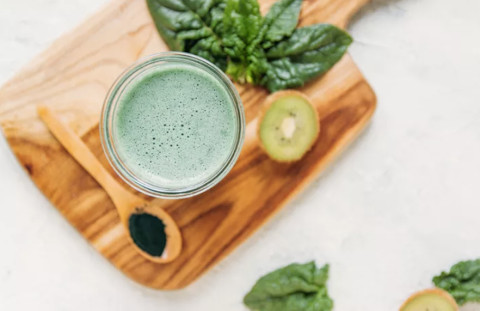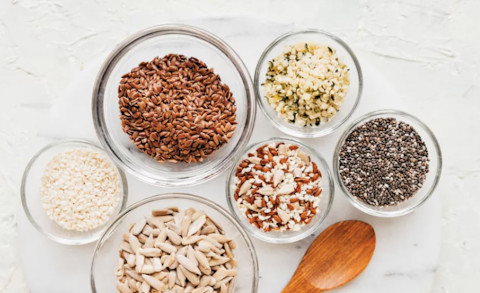
Vegan chef, recipe developer, and writer Lauren Kretzer is used to cooking balanced meals for family, friends, and clients—she's a contributing chef to by CHLOE and Kris Carr—but we wanted to know if she ever runs into issues cooking solely plant-based.
What's the number one question you get asked as a vegan chef?
If you're a vegan, you've almost certainly been asked—time and time again—the age-old question of, "Where do you get your protein?"
If you are considering trying out a vegan diet, you may have concerns about the dietary implications of giving up animal-based protein sources. Protein facilitates the building, maintenance, and repair of tissues in the body, so the thought of having insufficient amounts of this essential nutrient is just cause for concern.
The reality is, protein is an important macronutrient, but it's actually pretty difficult not to get enough if you're eating a well-rounded whole foods, plant-based diet. The Academy of Nutrition and Dietetics recently issued a statement supporting this claim, emphasizing that, "appropriately planned vegetarian, including vegan, diets are healthful, nutritionally adequate…[and] are appropriate for all stages of the life cycle, including pregnancy, lactation, infancy, childhood, adolescence, older adulthood, and for athletes."
So what exactly are our protein needs?

The long-established recommended daily allowance (RDA) is 8 to 10 percent of calories from protein. The average American following a typical Western diet consumes between 11 and 21 percent, and eating a vegan diet can easily provide 10 to 12 percent. To determine your individual protein needs, you can do the following calculation: Body weight (in pounds) x 0.36 = recommended protein intake (in grams). There are many resources available online to assist with finding protein values of specific vegan foods, such as this chart from the Academy of Nutrition and Dietetics, which may prove helpful in planning a balanced diet.
What are the best sources of plant-based proteins?
Protein is readily available in most vegan foods, including nuts, beans, legumes, whole grains, and even fruits and vegetables. Raw fruits and vegetables contain up to 15 percent protein content, and cooked beans and legumes can provide between 18 and 30 percent protein. Excellent sources of plant proteins include dark leafy greens, lentils, seitan, peanut butter, beans, split peas, broccoli, and bulgur. There are also several "complete proteins," or proteins that contain adequate proportions of all nine essential amino acids, available in a vegan diet: Quinoa, buckwheat, soy, hemp seed, and chia seed all fit the bill.
Is more protein better?

Since protein is an essential nutrient, it stands to reason that more is better, right? Not necessarily.
In a traditional Western diet, animal products remain the current "gold standard" for meeting our protein needs. This is partially due to animal proteins having a higher "biological value" than plant proteins, which means that the proportion of essential amino acids they contain is similar to what's required by our bodies. The caveat? Proteins with a higher biological value are linked to inflammation in humans and can increase IGF-1, an insulin-like growth hormone that is linked to the proliferation, metastases (spread), and invasion of cancer.
As for concerns of inadequate protein levels in vegan diets, protein deficiencies are extremely rare in the United States, so much so that the medical term for it, Kwashiorkor, is essentially unheard of here. Modern society is plagued far more by diseases of excess—heart disease, type 2 diabetes, and obesity, to name a few—than by deficiencies. Essentially, if your caloric needs are being met, you are almost certainly meeting your protein needs.
Exactly what should you eat on a plant-based diet?

Most of our societal concerns about the nutritional adequacy of vegan foods are actually perpetuated by how we view our plates. The typical American meal is comprised of a piece of "protein" (or meat), surrounded by a few vegetable or grain side dishes. Once the piece of meat is removed, the obvious protein is gone, and the remaining food is perceived as lackluster or nutritionally incomplete.
As Marion Nestle explains in her book Food Politics, protein is not a food, it's a nutrient—when you remove the animal meat from a plate, you're not removing all of the protein. Simply look at dinner plates around the world—Japan, Thailand, India, Italy, Mexico, to name a few—to see that vegetables, beans, legumes, and grains often take up more of the plate than meat does and still provide balanced, adequate nutrition.
Thankfully, foods on a whole-foods, plant-based diet are not only protein adequate, they are rich in vitamins, minerals, fiber, and phytonutrients and can help prevent, combat, and sometimes even reverse the very same chronic diseases that excess levels of animal-based proteins are linked to.
So the next time there is concern that a meatless dinner plate will leave you nutritionally deprived, rest assured that nutrient-dense plant-based foods provide everything you need and then some, without the negative side effects.
